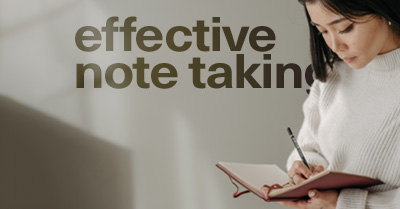
Pavel Danilyuk | Pexels
Taking notes is a very important skill in your professional, academic, and everyday life. Note taking is also personal. People try different ways of taking notes until they find what works best for them. However, you can learn from effective note-takers so you can improve your own note-taking.
Although you can take notes when you watch a lecture or video, when you create something (e.g., for writing), or when you meet with your team at work, this lesson will focus on note-taking as a reading skill.
Why Take Notes?
When you take notes, you engage in the learning process more actively. In addition to listening to, watching, and reading information, taking notes “forces you" to understand the content closely so you can write it down in your notes. You also engage your body by actually moving your muscles through writing your notes. You engage your visual sense and higher order thinking by organizing the content logically and meaningfully (for example, by outlining or graphing the information as you learn it).
In College
Learning from Reading Materials
The goal of reading in college is, of course, to learn content and to understand other people’s ideas. You should take notes when you read articles and textbook chapters and whenever you attend a lecture.
Before an exam, you need to review several weeks’ worth of reading materials and lectures. Taking notes helps you review and remember large volumes of information.
Taking notes when reading makes it easier to understand the material because you are actively trying to understand the information and how it is organized so that you can write it down. Taking notes also forces you to summarize because you write only the main points and most important details. When you summarize information, you learn and remember it better.

cottonbro studio | Pexels
Taking notes is an essential skill for students. It is easier to review and study what you learned because your notes reduce several pages of information to just a couple of pages of notes. It will take you less time to review all the information you learned.
Learning from Lectures and Audio Visual Materials
In most college courses, you will learn both from reading materials and from listening to lectures, participating in class discussions, watching documentaries and instructional videos, and so on. It does not matter whether you learned the material in the textbook or any other way; you may be tested on everything you have learned. If you take good notes, you can review all the information before an exam.
When you learn content from videos without taking notes, for example, the only way to review it is to watch the videos again. If you took good notes when you watched them, you can review your notes in a few minutes rather than watch the all the videos again.
At Work
Depending on your job, you may need to attend meetings, work on group projects, and follow oral instructions. If you take good notes during these activities, you can refer to your notes later and remember discussions, important decisions, assignments, and so on. You can also summarize large amounts of information you may need for a task. You can later review your notes to refresh your memory.
No “One Right Way” of Taking Notes
Taking notes is something you should develop over time. Create your own abbreviations, visual cues, and note-taking habits. Usually, only you will read your notes, so they do not need to be “neat.” Your notes must make sense only to you.
Common, helpful things to do when taking notes
Focus on the main points; include details only if they help clarify the main points.
Write short sentences and include key words.
Use abbreviations and symbols to speed up the process.
Create your own abbreviations and symbols. Unless someone else will read your notes, which does not happen very often, you are taking notes for yourself. As long as you understand your own symbols and abbreviations later, be creative.
Leave plenty of white space on the page so you can add information to your notes later.
Do not write linearly; instead, use both the horizontal and vertical space on the paper. Even note-taking software allows you to “draw” on your notes because doing so makes your notes more effective.
Write legibly, but do not try to be neat; focus on capturing key information.
Tips for Effective Note Taking
The more you take notes, the better you become at it. Here are some tips to get you started in the right direction or, if you already take notes frequently, to show things you may not have thought about.
Tips for effective note taking
Read purposefully. Before you start reading, spend a few seconds previewing the text by looking at the title, author, pictures, graphs, headings, and so on. This will give you an overview of what you are about to read. It will help you read and take better notes.
Focus on understanding the content. What does the writer want you to learn from the text?
Do not write in complete sentences. It is tempting to do so because you want everything written down; however, your focus should be on reading, not on writing.
Be selective. You are not “copying the whole text,” only writing down the important points.
For example, if the writer defines a new term and gives you two or three examples to clarify the definition, you likely need to remember the definition later, not the examples. Perhaps you can take quick notes on one of the examples if it will help you remember the definition later.
Look for “the big picture.” Reading (or listening) is not just about understanding words and sentences; it is about understanding whole ideas and thought processes. As you read or listen to a lecture or presentation, focus on understanding ideas, important connections, logical reasoning, possible inferences, and so forth.
When you read, keep in mind that writers organize their writing around a central point—that is the main point in the whole text. Then they elaborate on that central point by giving you chunks of information, which they expect their readers to digest one by one. They also tie these chunks of information together using transition words and expressions. Your notes should reflect not only “the parts” but how the ideas are related to one another.
Well written texts follow an outline that guides the flow of ideas. Read with that in mind so that your notes show how the ideas are outlined.
Review your notes as soon as possible—while the ideas are still fresh in your mind.
Reviewing your notes right away gives you the opportunity to absorb the information in the text as a whole, from beginning to end.
Fill in missing information and complete sentences you did not finish writing to make sure you will understand your notes later.
If needed, re-read portions of the text that you may not have understood as well as you thought. (You will know which they are because the ideas will be unclear in your notes.)
Reorganize the information in your notes to improve clarity.
Add your own questions or comments. (If you are reading for school, you can use your notes to remember what to ask the instructor for clarification.)
Create graphic representations of important information. Plainly put, use drawing to show important relationships between ideas, to summarize information, and so on.
Develop your own technique
Use whatever method of taking notes works for you. Notes are personal as most likely you are the only person who will read your class notes; therefore, develop techniques and shortcuts that work for you.
Study Notes and the Cornell Method
Many people use this method because it fits all the criteria of “effective note-taking.” You can use a template for the Cornell Method (opens in a new tab), but you can create your own template. All you need is paper. Draw a line down a blank piece of paper, creating a narrow column (about 30% of the page) from the left margin. Leave some space at the bottom.
On the top portion, write the name of the material you are summarizing. You can also write the date if that is important for you.
The main portion (right column) is for your notes.
Use the left column for keywords, headings, comments, and questions. You can use this information as a “map” for your notes. It also helps you visualize everything at a glance.
Write a summary at the bottom when you are done taking notes. If you can summarize the information, it means you understand the material. Otherwise, you likely need to re-read the text.
Video Activity 1
Watch How to Take Notes is a YouTube video showing how to take notes using the Cornell Method.
Congratulations on completing this material!

Thanks to our supporters!
This material has been made possible by supporters like you. Learn how you can support us.

“What should I learn next?”
Reading Purposefully is an enrichment article about reading purposefully, which can improve your reading comprehension and retention.
Thank you for Supporting Snap Language
Snap Language supporters make the creation of these materials possible.
Learn how you can support our work, get perks, and help us continue creating high-quality materials.
You can support us by simply white-listing this site.